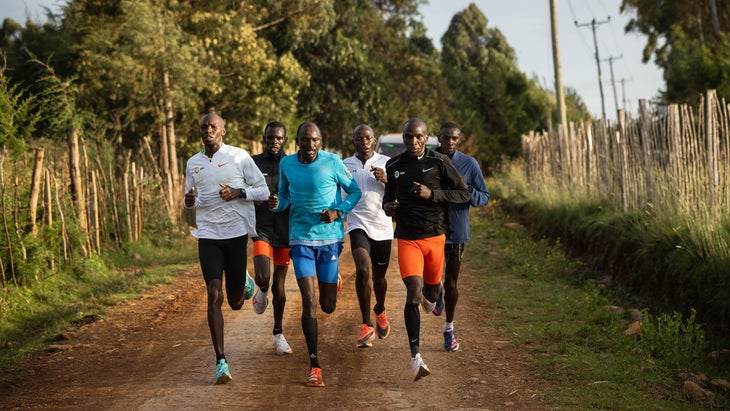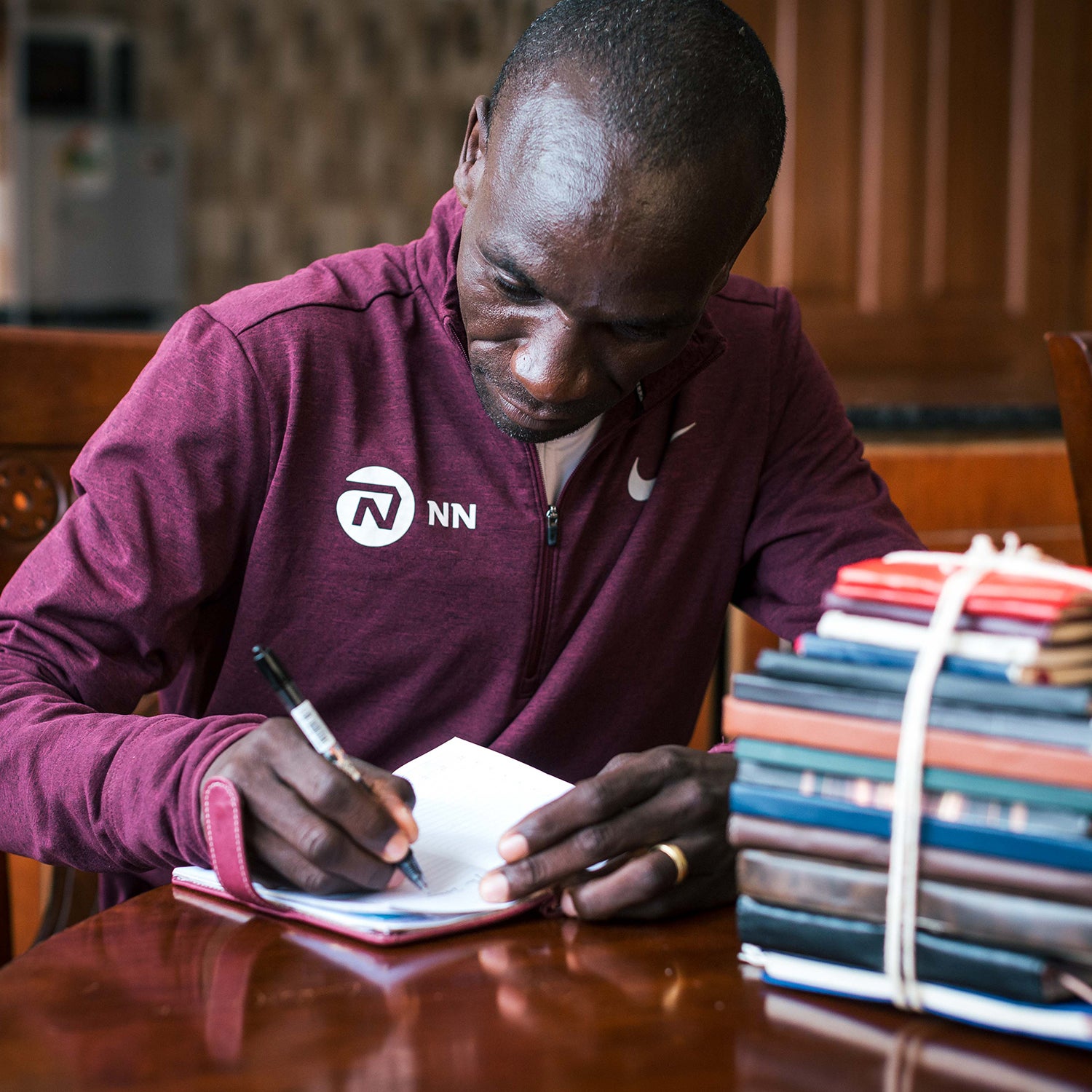The routine is always the same. For four months before every race, at his base in Kaptagat, Kenya, the fastest marathoner in history will churn through slight variations of the same workouts, week in, week out. After that he’ll show up and—almost without fail—dominate his rivals on the world stage.
Between 2014 and 2019, Eliud Kipchoge won ten consecutive major marathons. He is a two-time Olympic gold medalist, the marathon world record holder, and, of course, the first man to break the two-hour barrier for the distance.
The 36-year-old’s performances have been otherworldly for many years, but his lifestyle has stayed the same—humble, simplistic—while his training involves doing the basics well day after day, year after year.
What can the rest of us learn from Kipchoge? To find out, I spent three days in October visiting the NN Running Team camp in Kaptagat, which sits at 7,870 feet elevation, as Kipchoge returned to training following his latest Olympic success. Here are five training principles I observed, plus a look at Kipchoge’s weekly training schedule.
Cultivate Controlled Consistency

For Kipchoge, recovery runs start at a shuffle, typically an 8:30-to-8:45-minute-mile pace, and slowly build up to finish around 6:30 to 7 minutes per mile. That’s starting at four minutes per mile slower than his marathon pace, and still two minutes per mile off his marathon pace at the end. The goal here is to build overall volume—Kipchoge runs 124 to 136 miles each week—and ensure he’s ready to run fast for his next workout.
Though challenging, the workouts are controlled. “I try not to run 100 percent,” he says. “I perform 80 percent on Tuesday, Thursday, and Saturday and then at 50 percent Monday, Wednesday, Friday, and Sunday.”
Balance the Body
Twice a week, Kipchoge and his training partners perform a 60-minute session of strength and mobility exercises using yoga mats and resistance bands. The exercise program focuses on the posterior chain, particularly the glutes, hamstrings, and core muscles. It involves a series of glute abduction moves using resistance bands and the athletes’ body weight: bridges, planks, single-leg deadlifts, followed by proprioception and balance exercises and some gentle stretching to finish. He doesn’t lift weights, and the goal behind these exercises is chiefly injury prevention.
“The exercises are not something where you suffer,” says Marc Roig, the physiotherapist who oversees the routine. “The idea is that you’re not crushed. The idea is to create a very basic balance in the body. We know the important part is running, so we want to complement [it] a little bit and avoid any negative interference.”
Respect Recovery

For Kipchoge, every day starts at 5:45 A.M., and he’s in bed by 9 P.M. each night. During the day he’ll nap for an hour, while his spare time is spent reading or chatting with his teammates at the camp. Despite the many demands on his time, he’s very, very good at doing nothing.
Kipchoge drinks three liters of water each day and has worked with a nutritionist in recent years to improve his diet, mainly to include more protein. His meals are simple: homemade bread, local fruits and vegetables, lots of Kenyan tea, some meat, and a generous daily helping of favorite food—ugali, a dense maize-flour porridge. When it comes to supplements, Kipchoge told me he takes none.
He gets a massage twice a week with his physiotherapist, Peter Nduhiu, who has worked with him since 2003. “He’s been one very lucky guy,” Nduhiu says. “He hasn’t had injuries, but he makes it easy for me, because he follows what the coach says. If you’re managing an issue and tell him to slow down, he does exactly that.”
Document Every Detail
For most runners these days, recording workouts happens automatically via their watch, but Kipchoge still follows an old-school approach, logging every detail in a notebook. He began the practice in 2003 and now has 18 logs stored at his home to reflect on at the end of each season.
“I document the time, the kilometers, the massage, the exercises, the shoes I’m using, the feeling about those shoes,” he says. “Everything.” He is known to review these details and learn from them for future training cycles.
And they make a remarkable record of marathoning excellence. “I trust one day I will go through them and see what has been happening in the whole system,” Kipchoge says. “When I call off the sport, I will combine them and write about them one day.”
Let Your Pace Progress Naturally
“What’s the biggest mistake marathoners make?” I ask Patrick Sang, who has guided Kipchoge’s career for more than 20 years.
“Not listening to their bodies very well,” he says. “And not understanding what they are supposed to do.”
Sang likes his athletes to monitor effort—not with GPS watches or heart-rate monitors but by feel. When it comes to long runs, he doesn’t ask for a specific pace but an effort that’s controlled yet challenging, the pace naturally increasing each week as fitness builds.
Sometimes runners who join the group will head off at a crazy pace and mess up the other athletes, Sang says. On each run, the pace should get progressively faster, or at worst stay the same. Forcing the pace beyond your fitness does no good.
If you hammer the first half of a long run but can’t maintain it to the end, Sang says, “You’re on my list.”
A Champion’s Routine
After each marathon, Kipchoge takes three to four weeks completely off before beginning a three-to-four-week preparatory phase, during which he alternates an hour of strength exercises and step aerobics one day with an hour of easy running the next. When he shows up at camp, ready to begin his specific marathon training, Sang often has him do a set of 3K repetitions on the track to gauge his fitness.
Then it begins: the hard-easy approach that sees Kipchoge run fast three days a week and coast through the rest of his runs, sometimes at a comically slow pace. His marathon-training blocks have been as long as seven months and as short as three months, but typically they last around 16 weeks.
Here’s what a standard week of training looks like for Kipchoge right now, in the early stages of a training block for a yet to be disclosed spring marathon:
Monday
6 A.M.: 12 miles easy
4 P.M.: 6 miles easy
Tuesday
9 A.M.: A track workout totaling 9 to 10 miles of speed, run at marathon pace or slightly faster, on a rough dirt track.
Examples: 8 x 1,600 meters, run in 4 minutes 40 seconds, with two minutes of recovery; 8 x 400 meters, run in 63 to 64 seconds, with 30 to 50 seconds of recovery.
4 P.M.: 6 miles easy
Wednesday
6 A.M.: 12 miles easy
10 A.M.: 60 minutes of strength and mobility exercises
4 P.M.: 6 miles easy
Thursday
6 A.M.: A 19- or 25-mile run (alternate weeks)
Friday
6 A.M.: 12 miles easy
10 A.M.: 60 minutes of strength and mobility exercises
4 P.M.: 6 miles easy
Saturday
6 A.M.: Fartlek (13 x 3 minutes fast/1-minute jog)
4 P.M.: 6 miles easy
Sunday
Any time: 2 hours easy

